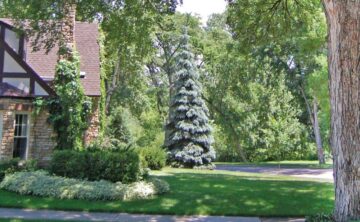Mowing Tips for Minnesota Lawns
Mowing your Minnesota lawn can seem like a daunting task. It can be time-consuming, requires owning and maintaining equipment, and small details like grass length and watering needs can be challenging to remember. Luckily, the Minnesota lawn experts at Rainbow Lawncare have compiled a list of lawn mowing tips, along with frequently asked questions (and their answers!), so you have a guide of best practices to refer to when mowing your lawn!
Why is proper mowing important to my lawn’s health?

Proper lawn mowing increases root depth, reduces weeds, and helps your grass resist diseases and insects. However, mowing improperly can be detrimental to your lawn. It can increase the need for water and fertilizer and promote weak, shallow root systems leading to decreased drought tolerance.
Minnesota Lawn Mowing Tips at a Glance
- Plan to mow from late April to early November
- Never cut more than ⅓ of the blade at a time
- Keep your blade sharp
- Mulch grass clippings for free fertilizer!
- Do not mow when the grass is wet
- Protect your eyes and feet
- Be sure kids and pets are indoors
How short should I cut my grass?
Our Minnesota lawn care experts recommend never removing more than ⅓ of the grass blade. If more is taken, the grass blades will take energy away from the roots as they try to regain the lost growth. This weakens your lawn, making it less tolerant of drought and more susceptible to diseases and weeds. If your lawn gets away from you, mow several times to reduce the height, leaving a few days between each mowing to reduce the stress on your lawn.
What are the benefits of taller grass height?
- Promotes deeper root growth, as the grass plants have long enough blades to make enough food through photosynthesis
- Decreases the likelihood of weeds germinating by crowding them out
- Requires less water because the taller grass keeps the soil shaded, reducing the amount of moisture lost through evaporation
Why is it important to mow my lawn using a sharp blade?
Mowing is a stressor on grass, but you can minimize damage by ensuring your mower blade is sharp.
- Dull blades rip and bruise the grass, leaving it frayed and battered. These frayed ends will discolor, giving your lawn a tan or brown appearance. They also provide a point of entry for diseases.
- If you are unsure how to sharpen your mower blade, check your owner’s manual.
Is it better to bag or mulch my grass clippings?
Leaving the grass clippings on your lawn provides you with free fertilizer. They are an excellent nitrogen source and can help your grass recover from the mowing process. Grass clippings generally degrade back into the soil within a week or two. Using a mulching mower speeds up this process and distributes the grass clippings more evenly.
Environmentally Friendly Lawn Mowing Tips for a Greener Minnesota
- Avoid spills. More than 17 million gallons of fuel are spilled yearly as lawn care equipment is refilled. Use safe gas containers, pour slowly, and tightly seal gas tank covers.
- Keep your gas mower well maintained, including regular oil and air filter changes. Four-stroke engines produce less pollution than two-stroke engines.
- Consider an eco-friendly push mower for smaller yards—or electric or solar-powered options.
How often should I mow my lawn?
Grass grows at different rates according to the season and the weather. Mowing once or twice a week may be needed during peak growing conditions in the spring and fall, and once every seven to ten days may suffice during hot and dry summer weather.
When should I start mowing my lawn in Minnesota? How late should I mow into the fall?
In Minnesota, you can usually begin mowing in late April and continue as needed into early November. There is a growing movement to avoid mowing too early in spring to provide undisturbed habitat for pollinators. Want your lawn to provide benefits to pollinators in May? In order to obtain a healthy and resilient lawn, the University of Minnesota recommends mowing as high as your mower will allow and often enough to avoid removing more than 1/3 of the height.
Does it matter what direction I mow my lawn? Should I use a pattern?
To avoid training your grass to lay in one direction and possibly looking less attractive, mow in a new direction each time. A fancy ballpark pattern might look great, but it will add time. Consider a happy medium for variety, for example, working from north to south one time and then reversing your mowing direction the next time. For best results, keep backward motions to a minimum, as lawn mowers are designed to make optimal cuts working forward.
Is it okay to mow my lawn when wet?
It is best to mow when your grass is dry. While it makes sense to work early in the day before it gets too hot, wait until morning frost or dew has dried. Working when the lawn is wet, and therefore softer, can cause damage such as soil compaction, tearing the turf, or carving ruts in the soil.
Safety first!
Always wear close-toed shoes or boots when mowing, and work across slopes to avoid slipping and falling under the mower. Eye protection, such as sunglasses, is also recommended. To avoid damaging your blade or sending a dangerous chunk of rock or wood flying, it’s a good idea to walk the yard and remove debris before you mow. Finally, be sure kids and pets are inside while you mow, as it can be difficult to hear them approach over the noise of the mower.
Believe it or not, a rock hit by a lawnmower blade can have the same impact as a bullet shot from a .357 Magnum revolver. This premise was confirmed in a 2015 episode of MythBusters, appropriately titled Accidental Ammo.
Interested in Rainbow Lawncare’s services?
Read more about our lawn care services, expertly designed for Minnesota lawns. After you mow, leave the rest to us!
Other items you may be interested in:

Tips for Watering Your Lawn in Minnesota
Why is watering your lawn important? Most living things require water to thrive, and your grass is no exception.

Identify & Manage Common Minnesota Weeds
Is your lawn invaded with weeds? Don’t panic, you’re not alone! Weeds are the most common lawn issue for homeowners in the Minneapolis & St. Paul

Why We Love Our Lawns: A Brief History Of American Lawn Care
America’s love affair with our lawns is as passionate as ever. However, some things have changed—including our image of the ideal lawn. One person’s dream



